
By CORY KOVACS and CARL CHRISTIANSEN
Michigan Department of Natural Resources
 On a
rainy August morning, three men dressed in dark-shaded green chest waders and
rain jackets slowly make their way upstream, through the chilly waters of the
Rock River in Alger County.
Two of
the men carry long white poles with rectangular boxed ends in one rubber-gloved
hand and a fishing net at the end of a wooden pole in the other.
From each
of the two men, a thick yellow electrical cord runs downstream to a blue or red
equipment box in a small aluminum boat, which is being pulled up the river by
the third man.
As the
men move the ends of the white poles under the stream banks, and the wet alder
trees overhanging the water, large and small brook trout begin to appear,
floating sideways or upside down in the creek.
Quickly,
the fish are netted and moved to a plastic bin filled with water that’s sitting
in the bottom of the boat. The men pull the boat to the muddy shore and they
begin measuring the fish and collecting information on each of them.
They work
quickly because it won’t be long before the fish have revived and are once
again darting under the banks of the stream, looking for places to hide.
|
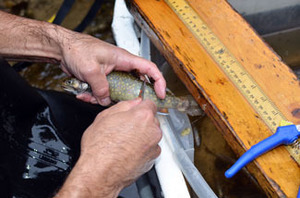 This
process is called electrofishing, and it’s been around for quite a while. The
men and women who perform this task for the state are fisheries biologists and
technicians with the Michigan Department of Natural Resources.
Within
the DNR, the Fisheries Division is responsible for managing fish populations
within the state’s streams, protecting and preserving these valuable resources
for the public and posterity.
Because every stream is unique, each one requires attention
to factors that may, or may not, have an impact on the fish community.
In every case, fisheries managers are trying to gather more
data on fish populations to help guide management recommendations.
How it
works
Electrofishing in Michigan got its start at the Hunt Creek
Research Station in Montmorency County during the summer of 1942.
|
There, the electrofishing unit first used in Michigan was a
1-horsepower gasoline motor that powered a 500-watt generator. The electrical
current was conducted to the water through a rubber-covered, two-wire cable using
a pair of electrodes that were attached to wooden handles. The two electrodes
used the water to complete the electrical circuit to the generator.
Today the concept is still the same, although the equipment
has come a long way since 1942. There are three main electrofishing tools used
by the DNR in Michigan.
The first is called a backpack shocker. It is designed for
small streams and is very portable. It runs off a 12-volt battery or sometimes
a small generator.
The second type is called a stream shocker. These units are
designed for larger streams that a backpack shocker cannot cover adequately,
and they are what the fisheries team was using on the Rock River that rainy day
in August.
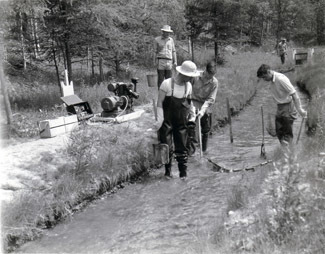 A stream shocker is made up of a small generator and a
control box that can alter the amount of current being produced by the
generator. The electric current flows from a positive to negative charged
direction.
These components are put into a small boat or barge. There
can be two or three anode (positive) electrodes on the boat (the red and blue
boxes), allowing several people to “shock” the stream at the same time. These
electrodes are often connected with cord reels, allowing the technicians to be
able to move away from the boat to get to different areas of the stream. The
boat acts as the other electrode (negative) or “cathode,” completing the
electrical circuit in the water.
The final, and largest, electrofishing tool is the boom
shocker. These tools are used on large rivers and lakes. They usually consist
of a 16- to 20-foot, flat-bottomed boat equipped with large booms, a
generator and a control box. The booms act as the anode (positive) electrode, and the boat serves as the cathode (negative) electrode.
All three types of electrofishing gear options
serve the same purpose. They produce an electric current in the water which temporarily stuns the fish, firing their muscles involuntarily, allowing
technicians to collect the fish and collect biological samples.
The fish are netted and placed in temporary holding tanks
to be sampled and then released back into the water of the stream or lake being
surveyed.
|
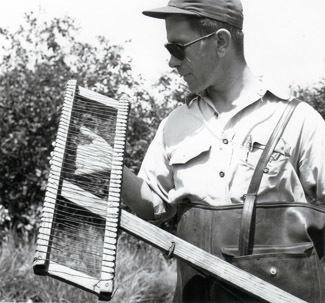 Uses
of the technology
For decades, fisheries managers have used electrofishing
gear to grow their knowledge about the fish community that lives in each stream
or lake.
The many uses for electrofishing gear, illustrating why it is a
critical tool for fisheries managers, include:
- Aiding
in estimating the number and type of species living within fish
communities.
- Collecting wild fish for egg gathering. The eggs are taken to fish hatcheries and
hatched. The fish produced from these eggs are used for stocking streams and
lakes.
- Providing
data to help judge the effectiveness of fisheries management actions.
- Monitoring
important fish species or non-native, invasive species that can harm fish
populations, water quality, recreation or economic concerns.
In the early 2000s, the DNR’s Fisheries Division developed
a standard process for stream sampling to compare fish populations between different
streams with similar habitat types. Electrofishing gear is used to collect
information from the populations in these streams.
Typically, information fisheries biologists, technicians
and managers are looking for includes length, fish species type and age. They
often will take scale or spine samples to help determine age.
|
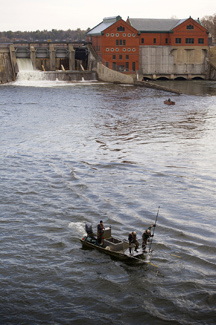 Examples
Under a rotation plan – three years of stream sampling, three
years without – the Rock River in Alger County, is sampled using the established
standard method. The stream contains a wild population of brook trout.
By sampling within a 1,000-foot length of stream, a
population estimate for brook trout is calculated from each sampling effort. From
the information gathered, trends in brook trout abundance, mortality and
growth can be identified, which are key components to fisheries management.
Every year during spring runoff, rivers rise, swollen with
snowmelt. In Newaygo County, the DNR’s Fisheries Division organizes a fleet of
electrofishing boats to head to the Muskegon River, below Croton Dam, in search
of walleye.
The Muskegon River serves as one of two locations in
Michigan where wild walleye brood stock (eggs used to grow fish populations) is collected. The second is Little Bay
de Noc in Delta County.
Because of the high and fast water conditions of the
Muskegon River during the spring spawning run, electrofishing boats are very
effective at successfully capturing spawning walleye. This provides the number
of eggs needed to meet targets for production at the Wolf Lake State Fish
Hatchery in Van Buren County.
Additionally, about one month later, on the east side of
Michigan, electrofishing boats search the Detroit River for muskellunge during
their spawning period. Great Lakes, or “spotted,” muskellunge have been the
primary focus for DNR Fisheries Division production since 2010.
|
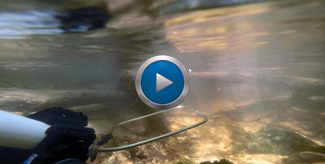 Until inland brood-stock lakes become well-established with
an acceptable population level of Great Lakes muskellunge, the DNR will rely
entirely on the Detroit River to collect eggs for its statewide muskellunge
stocking program.
In the early stage of this muskellunge program, efforts
with other gear types were unsuccessful on this massive waterbody. Today the
sole method for collection is with electrofishing boats.
Many times, anglers visiting a stream wonder,
“Why does this stream have a different fish size limit than another stream just
down the road?”
To answer this question, fisheries managers typically reply
with some data, biological reasoning and information that may seem like it just
came out of nowhere.
However, that information was most likely learned from data
collected during electrofishing, which supported a need for a fish
size restriction on one stream and not another.
Similarly, when a dam is removed after being in place for
years, fisheries managers will want to know what effects the removal has had on
the stream. Electrofishing gear most likely would be used to help evaluate the
changes in the fish communities, upstream and downstream of the dam site.
Another instance to consider is invasive fish species and
how the DNR and other entities identifies their occurrence or status. Invasive
species awareness has been of the utmost importance in recent years and on the
radar of every fisheries manager across the nation.
When someone reports seeing an invasive species to the DNR,
field staffers often conduct electrofishing surveys to determine the presence
or absence, and location, of the invasive species.
Responses to invasive species reports are relatively fast
using electrofishing gear, since all the components of the tools typically are found
within one unit, not requiring any significant amount of setup time.
|
Over the past three-quarters of a century, electrofishing
has found its place in fisheries management and research. The original uses of
this sampling equipment are still being applied today.
With the development, refinement and continued use of this
technology, questions once thought to be impossible to answer are now able to
be answered efficiently and confidently.
Electrofishing is a tool likely to remain important in
helping to protect and preserve Michigan’s thriving stream and lake fish
communities well into the future.
Get more
information on fishing in Michigan at www.michigan.gov/fishing. To
report potential invasive species, visit MISIN
or contact
the appropriate person for your area on the DNR’s invasive
species website with photos attached.
Check out
previous Showcasing the DNR stories in our archive at www.michigan.gov/dnrstories
To subscribe to upcoming Showcasing articles sign-up for free email delivery at
www.michigan.gov/dnr.
/Note to editors: Media contact: John Pepin, 906-226-1352. Accompanying photos are available below for download. Caption information follows. Credit Michigan Department of Natural Resources, unless otherwise noted.
Crew and Crew-2: A Michigan Department of Natural Resources crew works with electrofishing units to conduct a stream survey on the Rock River in Alger County.
Croton: A Michigan Department of Natural Resources crew uses electroshocking equipment on the Muskegon River below the Croton Dam.
Fin: A fin sample is taken from a brook trout during a stream survey in Alger County.
Lagler: A crew uses a Lagler Class boomshocker in this undated photo.
Sample: A scale sample is taken from a brook trout during a stream survey in Alger County.
Shocker: A stream shocking test is conducted in this undated photo.
Probe: A worker looks at a stream shocker in this undated photo.
Trout: A brook trout is shown from the Rock River in Alger County./
|